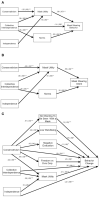Mask Wearing as Cultural Behavior: An Investigation Across 45 U.S. States During the COVID-19 Pandemic
- PMID: 34366970
- PMCID: PMC8333278
- DOI: 10.3389/fpsyg.2021.648692
Mask Wearing as Cultural Behavior: An Investigation Across 45 U.S. States During the COVID-19 Pandemic
Abstract
Although masks (face coverings) are a prime tool in fighting airborne pathogens, during the COVID-19 pandemic in the United States the use of masks encountered resistance based on existing patterns of cultural division. We argue that mask wearing must be understood basis on existing cultural frames assessed at both the individual level and the state level. We relied on prominent frameworks in cultural psychology: individualism-collectivism as well as independent and interdependent self-construals, the tightness-looseness framework, U.S. honor cultures, and political orientation as predictors. Using multilevel modeling, in a sample of 633 respondents from 45 U.S. states we investigated mask-wearing behavior, masks' perceived utility, implications for well-being, and the social meaning attributed to masks. Conservatism was linked to lower mask wearing, and consistently unfavorable perceptions of mask wearing. Collective interdependence predicted favorable perceptions of masks, as did state-level differences in collectivism; both constructs were linked with viewing mask wearing to be normative. Independent self-construal predicted a greater intent to wear masks, even though masks were also evaluated less favorably. Mediation analyses revealed that a single mediator, the perceived utility of mask wearing, was implicated in translating the effects of different cultural predictors into behavior. Additional findings highlighted that in tightener (vs. looser) states masks wearing was conceived of as a civic duty, whereas in U.S. honor states mask were seen as spoiling one's public image. Our discussion focuses on the cultural and political context of mask wearing, argues that different communities in the U.S. respond to its symbolic and social meaning, and suggest strategies to increase mask wearing among those who are otherwise reluctant to do so.
Keywords: COVID-19; conservatism; facial coverings; honor culture; independence; interdependence; tightness-looseness.
Copyright © 2021 Kemmelmeier and Jami.
Conflict of interest statement
The authors declare that the research was conducted in the absence of any commercial or financial relationships that could be construed as a potential conflict of interest.
Figures


Similar articles
-
Lay theories about emotion recognition explain cultural differences in willingness to wear facial masks during the COVID-19 pandemic.Curr Res Ecol Soc Psychol. 2023;4:100089. doi: 10.1016/j.cresp.2023.100089. Epub 2023 Jan 14. Curr Res Ecol Soc Psychol. 2023. PMID: 36685995 Free PMC article.
-
Theory-based Behavioral Predictors of Self-reported Use of Face Coverings in Public Settings during the COVID-19 Pandemic in the United States.Ann Behav Med. 2021 Feb 12;55(1):82-88. doi: 10.1093/abm/kaaa109. Ann Behav Med. 2021. PMID: 33301024 Free PMC article.
-
Exploring the Barriers and Facilitators of Mask-Wearing Behavior During the COVID-19 Pandemic in Taiwan, the United States, the Netherlands, and Haiti: A Qualitative Study.Disaster Med Public Health Prep. 2024 Feb 14;18:e23. doi: 10.1017/dmp.2024.4. Disaster Med Public Health Prep. 2024. PMID: 38351541
-
Children's experiences of mask-wearing: a systemic review and narrative synthesis.J Eval Clin Pract. 2024 Jun;30(4):585-621. doi: 10.1111/jep.13982. Epub 2024 Mar 27. J Eval Clin Pract. 2024. PMID: 38534010
-
Effects of mask-wearing on social anxiety: an exploratory review.Anxiety Stress Coping. 2021 Sep;34(5):487-502. doi: 10.1080/10615806.2021.1929936. Epub 2021 Jun 1. Anxiety Stress Coping. 2021. PMID: 34074171 Review.
Cited by
-
Exploration of the impact of political ideology disparity on COVID-19 transmission in the United States.BMC Public Health. 2022 Nov 24;22(1):2163. doi: 10.1186/s12889-022-14545-3. BMC Public Health. 2022. PMID: 36424566 Free PMC article.
-
The role of honour in interpersonal, intrapersonal and intergroup processes.Soc Personal Psychol Compass. 2023 Jan;17(1):e12719. doi: 10.1111/spc3.12719. Epub 2022 Dec 11. Soc Personal Psychol Compass. 2023. PMID: 37033685 Free PMC article. Review.
-
Collectivism, individualism and COVID-19 prevention: a cross sectional study of personality, culture and behavior among Canadians.Health Psychol Behav Med. 2022 Apr 30;10(1):415-438. doi: 10.1080/21642850.2022.2069571. eCollection 2022. Health Psychol Behav Med. 2022. PMID: 35528715 Free PMC article.
-
Population Behavior Regarding the Use of Face Masks to Prevent the Transmission of Respiratory Infections: Lessons to Be Learned from the COVID-19 Pandemic.Int J Environ Res Public Health. 2025 Jan 22;22(2):147. doi: 10.3390/ijerph22020147. Int J Environ Res Public Health. 2025. PMID: 40003373 Free PMC article.
-
Factors associated with COVID-19 masking behavior: an application of the Health Belief Model.Health Educ Res. 2022 Nov 21;37(6):452-465. doi: 10.1093/her/cyac031. Health Educ Res. 2022. PMID: 36263961 Free PMC article.
References
-
- Acosta J., Vazquez M. (2020). Trump Still Not Grasping the Severity of the Pandemic, Source Tells CNN. CNN. Available online at: https://www.cnn.com/2020/08/05/politics/donald-trump-coronavirus-pandemi... (accessed December 28, 2020).
-
- American Community Survey (2021). Income Inequality by State 2021. Available online at: https://worldpopulationreview.com/state-rankings/income-inequality-by-state
-
- Anderson E. (1994). The code of the streets. Atlantic Monthly, 273, 81–94. (accessed September 20, 2020).
LinkOut - more resources
Full Text Sources

